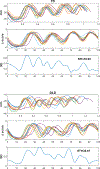A developmental account of the role of sequential dependencies in typical and atypical language learners
- PMID: 37963089
- PMCID: PMC10939949
- DOI: 10.1080/02643294.2023.2275837
A developmental account of the role of sequential dependencies in typical and atypical language learners
Abstract
The Gerken lab has shown that infants are able to learn sound patterns that obligate local sequential dependencies that are no longer readily accessible to adults. The Goffman lab has shown that children with developmental language disorder (DLD) exhibit deficits in learning sequential dependencies that influence the acquisition of words and grammar, as well as other types of domain general sequences. Thus, DLD appears to be an impaired ability to detect and deploy sequential dependencies over multiple domains. We meld these two lines of research to propose a novel account in which sequential dependency learning is required for many phonological and morphosyntactic patterns in natural language and is also central to the language and domain general deficits that are attested in DLD. However, patterns that are not dependent on sequential dependencies but rather on networks of stored forms are learnable by children with DLD as well as by adults.
Keywords: Language development; artificial grammar; developmental language disorder; infants; motor skill; phonotactics; sequencing.
Figures


Similar articles
-
Not All Procedural Learning Tasks Are Difficult for Adults With Developmental Language Disorder.J Speech Lang Hear Res. 2021 Mar 17;64(3):922-934. doi: 10.1044/2020_JSLHR-20-00548. Epub 2021 Feb 16. J Speech Lang Hear Res. 2021. PMID: 33592156 Free PMC article.
-
Phonological and Articulatory Deficits in the Production of Novel Signs in Children With Developmental Language Disorder.J Speech Lang Hear Res. 2023 Mar 7;66(3):1051-1067. doi: 10.1044/2022_JSLHR-22-00434. Epub 2023 Feb 16. J Speech Lang Hear Res. 2023. PMID: 36795546 Free PMC article.
-
Behavioral and Imaging Studies of Infant Artificial Grammar Learning.Top Cogn Sci. 2020 Jul;12(3):815-827. doi: 10.1111/tops.12400. Epub 2018 Dec 15. Top Cogn Sci. 2020. PMID: 30554481 Review.
-
Non-adjacent Dependency Learning in Humans and Other Animals.Top Cogn Sci. 2020 Jul;12(3):843-858. doi: 10.1111/tops.12381. Epub 2018 Sep 8. Top Cogn Sci. 2020. PMID: 32729673 Free PMC article. Review.
-
Tuning in to non-adjacencies: Exposure to learnable patterns supports discovering otherwise difficult structures.Cognition. 2020 Sep;202:104283. doi: 10.1016/j.cognition.2020.104283. Epub 2020 Jul 2. Cognition. 2020. PMID: 32623134 Free PMC article.
Cited by
-
Co-design to consensus: Identifying the core elements of a novel intervention for pre-school children with co-occurring phonological speech sound disorder (SSD) and developmental language disorder (DLD) using a modified e-Delphi approach.PLoS One. 2025 Jun 18;20(6):e0326072. doi: 10.1371/journal.pone.0326072. eCollection 2025. PLoS One. 2025. PMID: 40531945 Free PMC article.
References
-
- Anderson ND, & Dell GS (2018). The role of consolidation in learning context-dependent phonotactic patterns in speech and digital sequence production. PNAS Proceedings of the National Academy of Sciences of the United States of America, 115(14), 3617–3622. doi:10.1073/pnas.1721107115 - DOI - PMC - PubMed
-
- Bedore LM, & Leonard LB (2001). Grammatical morphology deficits in Spanish-speaking children with specific language impairment. Journal of Speech, Language, and Hearing Research, 44,905–924. PMID: 11521782 - PubMed
Publication types
MeSH terms
Grants and funding
LinkOut - more resources
Full Text Sources
Miscellaneous
